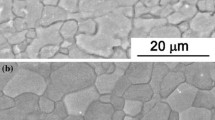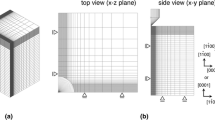Abstract
Dual-stage, constant loading-rate followed by constant-load, pyramidal indentation experiments were performed to investigate the strain-rate (105-101/s) and temperature (295-573 K) dependence of pure magnesium. The estimated total activation energy, Q (0.69-1.01 eV), and apparent activation volume, V (17-28b3), indicate that plastic deformation is controlled by a dislocation cross-slip mechanism. The results from this work and previous studies confirm that, during pyramidal indentation of Mg, the operative deformation mechanism remains the same over a very wide strain-rate and temperature range.




Similar content being viewed by others
References
H. Somekawa and C.A. Schuh: Nanoindentation behavior and deformed microstructures in coarse-grained magnesium alloys. Scr. Mater. 68, 416–419 (2013).
C.L. Wang, T. Mukai, and T.G. Nieh: Room temperature creep of fine-grained pure Mg: a direct comparison between nanoindentation and uniaxial tension. J. Mater. Res. 24, 1615–1618 (2009).
V. Sklenička, M. Pahutová, K. Kuchartová, M. Svoboda, and T.G. Langdon: Creep processes in magnesium alloys and their composites. Metall. Mater. Trans. A. 33, 883–889 (2002).
S.R. Agnew, M.H. Yoo, and C.N. Tomé: Application of texture simulation to understanding mechanical behavior of Mg and solid solution alloys containing Li or Y. Acta Mater. 49, 4277–4289 (2001).
C.M. Cepeda-Jiménez, J.M. Molina-Aldareguia, F. Carreño, and M.T. Pérez-Prado: Prominent role of basal slip during high-temperature deformation of pure Mg polycrystals. Acta Mater. 85, 1–13 (2015).
H. Somekawa and C.A. Schuh: High-strain-rate nanoindentation behavior of fine-grained magnesium alloys. J. Mater. Res. 27, 1295–1302 (2012).
H. Somekawa and C.A. Schuh: Effect of solid solution elements on nanoindentation hardness, rate dependence, and incipient plasticity in fine grained magnesium alloys. Acta Mater. 59, 7554–7563 (2011).
D. Catoor, Y.F. Gao, J. Geng, M.J.N.V. Prasad, E.G. Herbert, and K.S. Kumar: Incipient plasticity and deformation mechanisms in single-crystal Mg during spherical nanoindentation. Acta Mater. 61, 2953–2965 (2013).
K. Ito: The hardness of metals as affected by temperature. Tohoku Sci. Reports 12, 137 (1923).
J.H. Westbrook: Temperature dependence of the hardness of pure metals. Trans. A.S.M. 45, 221 (1953).
V. Bhakhri, J. Wang, N. Ur-rehman, C. Ciurea, F. Giuliani, and L.J. Vandeperre: Instrumented nanoindentation investigation into the mechanical behavior of ceramics at moderately elevated temperatures. J. Mater. Res. 27, 65–75 (2012).
U.F. Kocks, A.S. Argon, and F. Ashby: Thermodynamics and Kinetics of Slip (Pergamon Press, Oxford, 1975).
H. Watanabe, A. Owashi, T. Uesugi, Y. Takigawa, and K. Higashi: Grain boundary relaxation in fine-grained magnesium solid solutions. Philos. Mag. 91, 4158–4171 (2011).
H.J. Frost and F. Ashby: Deformation-Mechanism Maps: The Plasticity and Creep of Metals and Ceramics (Pergamon Press, Oxford, 1982).
J. Koike, T. Kobayashi, T. Mukai, H. Watanabe, M. Suzuki, and K. Maruyama: The activity of non-basal slip systems and dynamic recovery at room temperature in fine-grained AZ31B magnesium alloys. Acta Mater. 51, 2055–2065 (2003).
V.A. Lubarda, M.A. Meyers, and O. Vo: The onset of twinning in metals: a constitutive description. Acta Mater. 49, 4025–4039 (2001).
T.-S. Shih and Z.-B. Liu: Thermally-formed oxide on aluminum and magnesium. Mater. Trans. 47, 1347–1353 (2006).
A. Galiyev, R. Kaibyshev, and G. Gottstein: Correlation of plastic deformation and dynamic recrystallization in magnesium alloy ZK60. Acta Mater. 49, 1199–1207 (2001).
V. Maier, B. Merle, M. Göken, and K. Durst: An improved long-term nanoindentation creep testing approach for studying the local deformation processes in nanocrystalline metals at room and elevated temperatures. J. Mater. Res. 28, 1177–1188 (2013).
D. Tabor: The Hardness of Metals (Oxford University Press, Oxford, 2000).
Acknowledgments
Authors wish to thank the Natural Science and Engineering Research Council (NSERC) for providing financial support for this work.
Author information
Authors and Affiliations
Corresponding author
Rights and permissions
About this article
Cite this article
Haghshenas, M., Bhakhri, V., Oviasuyi, R. et al. Effect of temperature and strain rate on the mechanisms of indentation deformation of magnesium. MRS Communications 5, 513–518 (2015). https://doi.org/10.1557/mrc.2015.57
Received:
Accepted:
Published:
Issue Date:
DOI: https://doi.org/10.1557/mrc.2015.57




